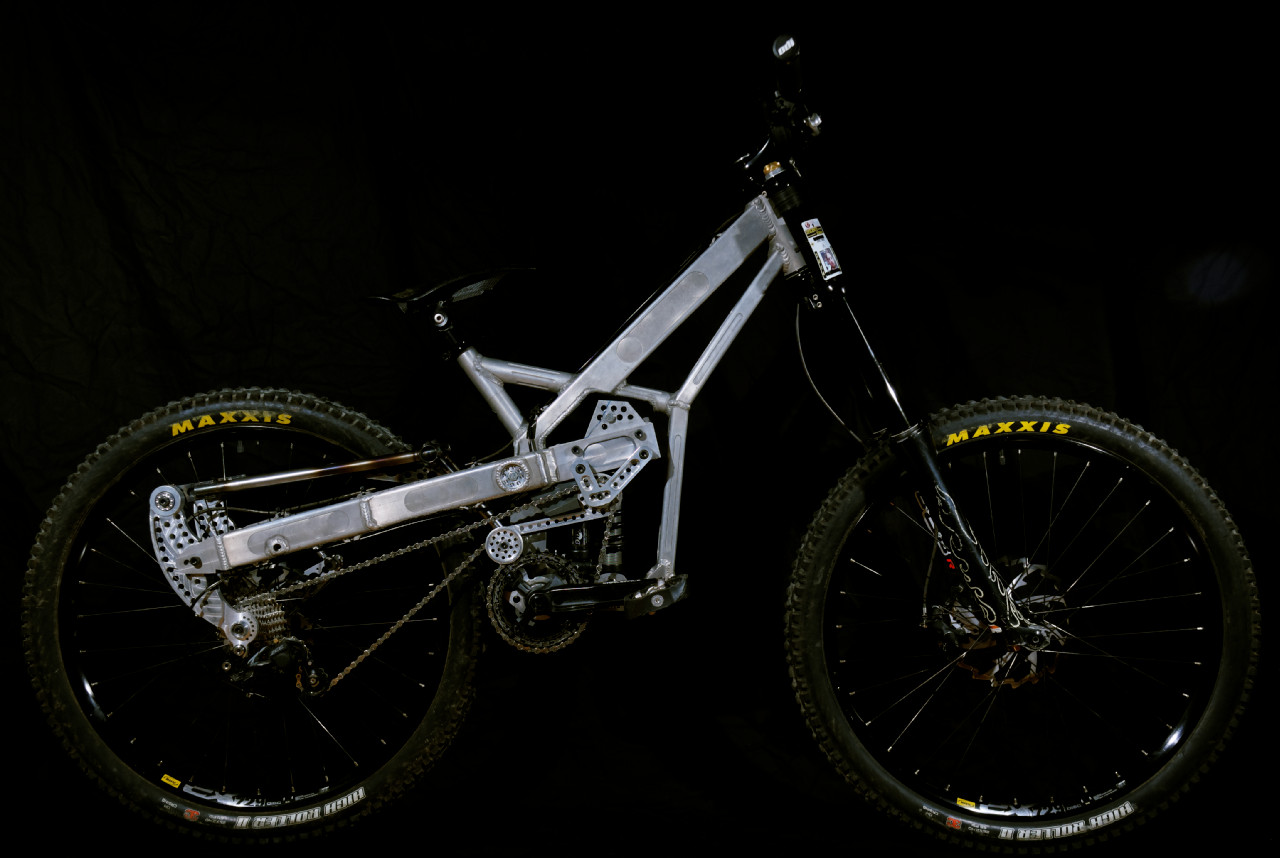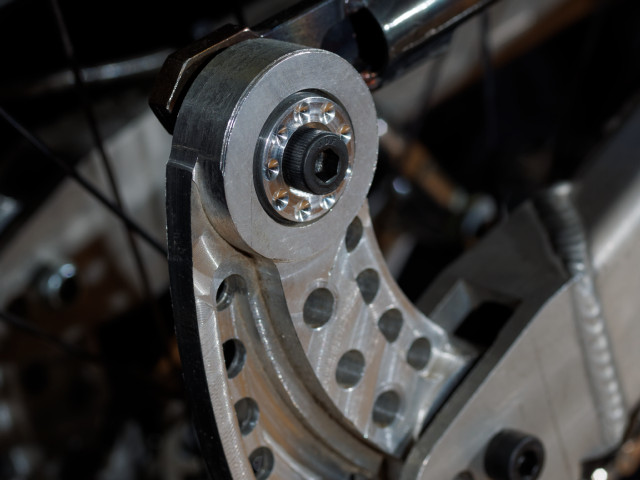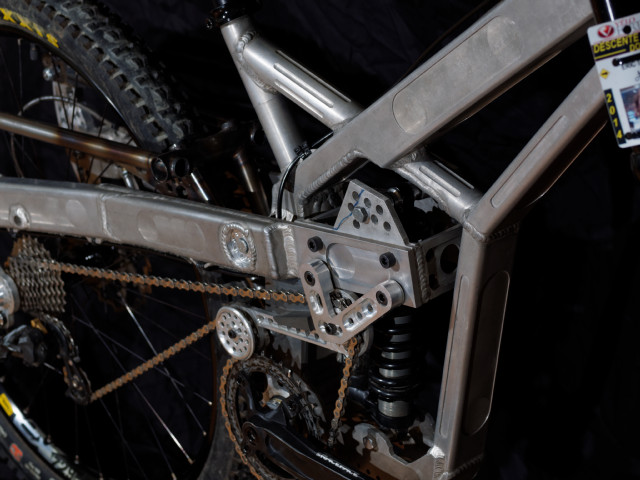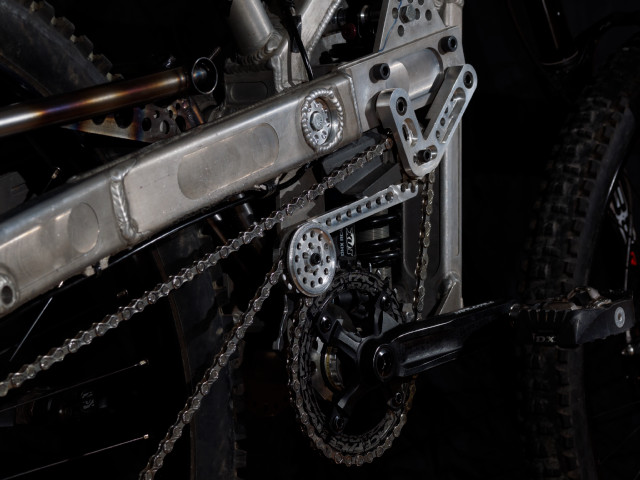 |
|
 |
|
 |
|
 |
|
 |
|
 |
|

This is the CatLander TrebuChat*.
See detailed images below.
|
|
General
It's a 50lb bike.
That's about 23kg - 3.6 stone - 800oz. It doesn't weigh a ton; it weighs about 0.023 tons.
I know that I can simply type: PROTOTYPE and all is to be forgiven but the reality of why it weighs what it does is rooted in my intent for this prototype. I wanted to ride it as my next and last bike. I don't have FEA (Finite Element Analysis) Kung Fu. I based things on experience with where other frame failures occur and then set a "building code" based on at least meeting the specifications of my previous bike, a 2003 Balfa BB7. That was the goal, at least as strong as a Balfa, stronger if I could. The frame tubing is at least 3mm thick with shallow external butting relief cut into it. The point was to demonstrate that material could be removed, not to thin the bike out to being a lightweight FRO model. The headtube wall thickness is over 5mm thick, I wanted to give my welders lots of material to ensure a good weld was easier to make. There is, quite seriously, about twice the material required.
Any skillful bicycle manufacturer would instantly save weight by bringing the tubing wall thickness down to reasonable numbers, making the feet out of carbon fibre (or fiber, if you like), replacing the 3/4lb of the nuts and bolts involved with about 1/8lb of aluminum fasteners threaded into frame material and not even allowing anyone to ever mention the 1/4" (6mm) tire rub protection plates inside the legs of the prototype.
I'll also point out that, because I won't adopt change, the bike runs an 8lb fork and 3lbs of inner tubes.
The last comment on its weight:
This is a prototype of two inventions patented within the last few years; weight was my last concern, it is the first thing many folks seem to ask.
Styling
The reason it looks like it does has two driving factors. My previous bike was a Balfa BB7; when trying to design a front triangle for a bike that would suit the purpose I couldn't think of anything with more design efficiency and manufacturing simplicity.
The second driving factor was a conversation with an engineer from the second bike company to say no. After presenting the drawings in the patent application I was told that the bike looked heavy. My reply was that we were looking at "drawings for a patent application, I could have used thinner lines". The engineer then advised that it looked like there was a lot of metal in the middle section. There! I had the styling theme. All styling was based on meeting the criteria hierarchy of: Functional & Strong, Easy to Make, Less Heavy, More Heavy Metal.
I think it turned out exactly how I envisioned it after bike company rejections. Blended into the theme of Heavy Metal, you might notice hints of Steam Punk and Sci-Fi Alien Weaponry.
26" Wheels
I know! You're all allowed to laugh at me... it took me over 5 years to make my prototype. I researched suspension designs and patents, I actually cite a patent from 1898 and researched further back than that.
I went over 100 years into the past researching technology and in the 5 years it took me to make a bike - the bike industry:
- Started using a different size of wheel (again 27.5" = 650B).
- Changed and added head tube specifications
- Got rid of threads in the BB and made a bunch of new specifications
- Made cups in the rear dropouts
- Made gears go to 11
The Patent that I cite from 1898 has the line in what would qualify as the Inventor Oath: "I [Inventor Name], a citizen of the Czar of Russia...". Seriously, I looked into technology from the time that
Russians were not only called Russians, but when the Russians had Czars. Actually technically by 1898 the term Emperor was the official designation but Czar was still understood in common usage.
Go ahead and make fun of me for using 26" wheels (The 559mm Kind).
Just so you know, if you undo two nut and bolt fasteners, move the foot to any position other than the Extra Short (and maybe the Short) configuration the TrebuChat is 650B / 584mm / 27.5" compatible.
The Ride
It literally rides like my dreams.
To have a project of this scope and magnitude turn out at all is a little bewildering. To have it meet all of my expectations and hopes in terms of ride quality is how I'll describe the ride. I know that's as vague as using the word AMAZING (this tells you nothing - young children are amazed by that trick where it looks like you can take the end of your thumb off). If you want facts on the ride, read the info in the Patents section.
| Head Tube Angle | Steep: 61.5° - Slack: 60.5° |
| Bottom Bracket Height | High: 14.75" (374mm)
Low: 13.5" (342mm) |
| Chainstay Length | Extra Short - Unweighted: 16.75" (425mm) - Fully compressed 22" (559mm)
Short - Unweighted: 17.25" (438mm) - Fully compressed 22.5" (572mm) Long - Unweighted: 17.75" (451mm) - Fully compressed 23" (584mm) Extra Long - Unweighted: 18.25" (463mm) - Fully compressed 23.5" (596mm) |
| Reach | 14" (355mm) really rough measurement |
| Stack | 23" (583mm) really rough measurement |
Details
Click on any of the images below for detailed description of what you're looking at and why it was done that way.
 |
 |
 |
 |
 |
|